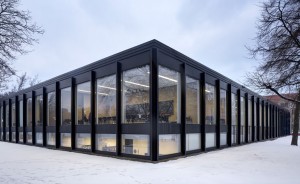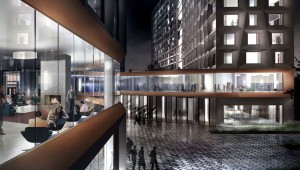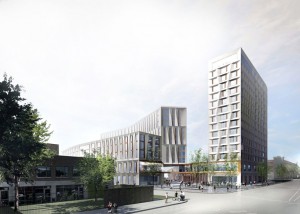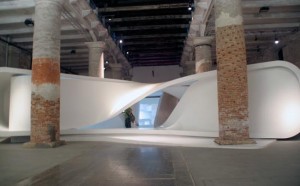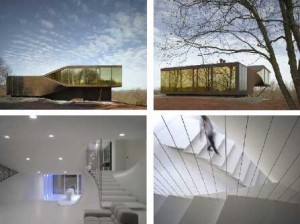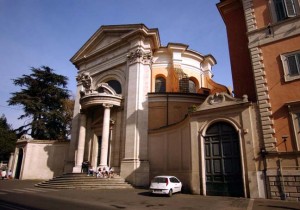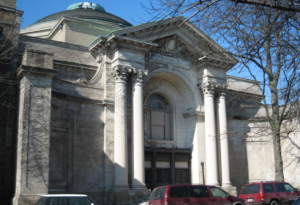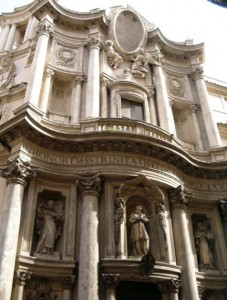I am a sensible anthropologist-architect thinking about the built environment in Hyde Park, generally, at the University of Chicago, specifically. This paper will parse this banal encapsulation of my virtual self — which is a non-body — into its differnciated incarnation, both in matter and, now, language. This first journal entry will hold up a mirror representing myself as architect-anthropologist-in-Hyde-Park, standing before another mirror reflecting this reflection; this second mirror is Deleuze’s theories, the one that distributes a singular form across infinite virtual forms (reflections on virtual mirrors), simulating a multiplicity that exists behind Cartesian space and time. “There is more in heaven and earth,” and Hyde Park, “than is dreamt of in our Philosophy,” to repeat, differentially, Hamlet’s musing to Horatio. This essay plucks several of Deleuze’s arrow from the midway and, pointing it the general direction of the University’s architecture, fires questions and thoughts regarding novelty, translation, the involuntary, and erotics at its sundry forms. To what plane of architectonic thinking do these structures extend from? How is space-time folded in the indexical and mnemonic relations amongst these structures, and through my experience of them? How are projects under construction and those only anticipated correspond with this plane of immanence?
Two central concerns addressed in this course (in Hyde Park) thus far are: one, Deleuze’s exploration of the immanent relationship between art and philosophy and, two, his exposition of philosophical morphogenesis, or the study of how forms come into being. Our discussions have unfolded in Cobb Hall, a renovated Gothic Revival building constructed early in the University’s history when its administrators and benefactors decided to repeat, with some key differences, the Gothic forms of Oxbridge and Ivy League architecture. Since the 11th century, Gothic forms have been commonly associated with the scholastic and the ecclesiastical; it is an image of the architecture within which thought — in ‘the west’ — is doxically expected to occur. Almost equidistant from Cobb hall, but in opposite directions, stand two more contemporary structures separated in (machine) time by a generation: Mies van der Rohe’s 1965 School of Social Services building, to the South, and Studio Gang’s design for the new residence halls, under construction precisely six blocks to the north. The former is a three story edifice clad in a series of identical, repetitive vertical elements that alternate consistently between column and mullion, in between which spans large panes of glass. This is a modernized classical form: like that of the Stoa of
School of Social Service, by Mies van der Rohe
Atalos or other Greek trabeated colonnades, which repeat a consistent interval of columns and bays around the perimeter of a building. However, it is flamboyantly (second Chicago school) modernist in its minimalization of the structural elements and expression of its steel structure. Studio Gang’s design is a dramatically larger complex of low and mid rise structures the facades of which are, similarly, articulated in repeated columns and bays, extending between 5 and 14 stories in height. Again, the ‘image’ of an Agora with serial colonnade surfaces reappears, but in noticeably transformed iterations that both reference and differentiate themselves from the Stoa and Mies’s building. All columns (which are in fact identical to the to the others) are clad in panels of varying widths that appear to twist 180 degrees along their vertical axes. The bays between each column along each structure also appear different: a repetition of difference. This columnar cladding provides the illusion that each column undulates up and down the facade, serially, creating irregular shaped bays when, in fact, each window is actually square. Both Mies and Gang were and are, like the best of their contemporaries, impelled towards morphological innovation, the mandate to create a recognizably ‘new’ architecture for a ‘new’ context that the existing neo-Gothic fabric of the campus only enunciates through contrast. What “nonphilosophical understanding,” which Deleuze gleans from Art, can this formal juxtapositioning and temporal interconnectedness reveal?
University of Chicago Residence Halls, Studio Gang
The emergence of the Mies – Cobb – Gang triad differnciates ideas into incarnate form. I hesitate to bracket or presume to recognize any single idea, because, as Deleuze argues, ideas are themselves tripartite, distributed across the vertices of extension, intension and the virtual. The buildings are instantiations, or extensivities, of underlying thought, and their singular formal articulations are outbursts of something pre-image, pre-architectonic that is virtual. In their extensive, materially constructed forms that we now experience, they are generative in our thoughts and embodied experience as we move through and around them. I, as an architect- anthropologist, am obviously more consciously biased to what Benjamin would describe as the temporal constellations of the “dialectical image” that the University is continually populating, a cosmos linking the intensions that manifest in such repeated yet different extensions:
It’s not that what is past casts its light on what is present, or what is present its light on the past; rather, image is that wherein what has been comes together in a flash with the now to form a constellation. In other words, image is dialectics at a standstill. For while the relation of the present to the past is a purely temporal, continuous one, the relation of what-has-been to the now is dialectical: is not progression but image, suddenly emergent.
Deleuze would resist the bracketing of such interactive dynamics across space time in the form of the dialectic. And, conscious or no, the potentiality of these relations across space-time ‘fold’ through the triadic structure of the concept. “Affects, percepts and concepts are three inseparable forces, running from art into philosophy and from philosophy into art.” Percepts and affects are two dimensions of the concept, the former are “packets of perception that live beyond whoever experiences them” and the latter “becomings that spill over beyond whoever lives through them.” The Mies | Cobb | Gang buildings are points along a differential equation, to use Deleuze’s choice calculus imagery, or architectural knots on the fold of a deeper plane that pass through our perceptions and experiences of them in the forms of affects and percepts.
I am trepidatious about making too strong an association with Deleuze’s ontological claims on difference and repetition and the manifestation of difference and repetition amongst, first, buildings defined by repetitive colonnaded facades and, second, within even a single facade, like the Gang complex. Deleuze’s concept of ‘the fold’ has been directly transduced into many folding, continuous architectural surfaces by the architectural progeny of the 1968 coterie of thinkers and artists, of which UN Studio’s Mercedes Museum, the ‘Changing Room’ for the Venice Biennale, and Villa NM are the most exemplary instances. And yet, Deleuze himself refers to artistic work of the Baroque that shares a common, almost metaphorical formal similitude to his and Leibniz’s conceptualization of folding. “Everything folds, unfolds, enfolds in Leibniz; it’s in the folds of things that one perceives, and the world is enfolded in each soul, which unfolds this or that region of it according to the order of space and time.” This folding happens through percept and
UN Studio, “Changing Room” at the Venice Biennale for Architecture
UN Studio, House NM
affect as we circulate among the Mies | Cobb | Gang structures. Deleuze argues that “the baroque carries folding to infinity, as in El Greco’s paintings and Bernini’s sculptures, and so opens the way to a nonphilosophical understanding through percepts and affects.” El Greco’s figures stretch, taper and torque across the canvas, manipulating perspectival space into a more fluid image of space. Oddly, Deleuze’s reference to Bernini’s sculptures, and not his architecture (!), seems like a surprisingly, frozen-image transduction of folding in extension. His sculptures are exquisite: their physical contortions and supple rendering of flesh are masterful copies of their models, and action is frozen in the arrested billowing of flowing and folding garments. Yet, classical space, unlike in El Greco, is preserved. Bernini’s architecture, however, is revolutionary for how it bends, stretches and folds classical architectural conventions. His design for Sant Andrea Al Quirinale, for instance, bends what would otherwise be a flat wall below the entablature, as well as the portico’s entablature itself into a concave curve, and the compound walls that extend beyond this facade he then reverses, folding the lines backwards into a convex curve that envelops any passersby along the street it faces. The lines of the concave armature extend and visually connect with the stringcourses and geometries of what was the neighboring palazzos. Deleuze, without knowing it, describes the effect performed spatially by Bernini but in
Bernini, Sant Andrea Al Quirinale
another article, “What is an Event,” analyzing Leibniz and Baroque music: “In short, the Baroque universe witnesses the blurring of its melodic lines, but what it appears to lose it also regains in and through harmony. Confronted by the power of dissonance, it discovers a florescence of extraordinary accords, at a distance, that are resolved in a chosen world.” Folding together Deleuze’s descriptions of the morphological qualities of Baroque painting, sculpture and music — and inadvertently, architecture — a common virtual idea diffenciates itself in the bending, coalescing transformations of pictorial, sonic and architectural extensivities. Bending, torquing, stretching and folding are read against classical and renaissance conventions of balance, symmetry and order; this difference of formal and spatial relations are repeated across artistic media in Baroque space-time. Perhaps, then, it is not a stretch to entertain such thoughts as I encounter when walking up Woodlawn avenue, witnessing the repetition of repetition (columns) becoming increasingly expressive of internal difference (as in Gang’s twisted, somewhat Baroque columns).
If my prose or accompanying images fail to conjure a clear image of such complex Baroque geometry, no worries, we live in Hyde Park! Just walk along Blackstone between 56th and 57th street, just four blocks west of the axis between Mies | Gang, and stand in front of the
St Stephens Church, Hyde Park
shuttered doors of St Stephen’s church. Here you will find a distinct repetition of the Baroque bending of the facade into a concave embrace that Bernini created in Rome at Sant Andrea. The form has, what Peirce would call, an indexically iconic relation to the sign of Sant Andrea, which itself iconcially and indexically related to the neoclassical Renaissance conventions it was distorting. Each instance is a translation, literally across space, time and form, of the other, induced by the encounter of a day’s dog-walking itinerary from my home, down Blackstone, across the midway and up Woodlawn Ave. The resulting psycho-geographical map would have to plot these four buildings within a complex four dimensional model of space and time connected one to the other and to the signs they are repeating differentially from ancient Greece to the present. This, and the ruminations clumsily unfolded in this journal entry, are my thoughts ensuing from encounters with these interconnected sign systems. According to Deleuze,
what forces us to think is the sign. The sign is the object of an encounter, but it is precisely the contingency of the encounter that guarantees the necessity of what it leads us to think. The act of thinking does not proceed from a simple natural possibility; on the contrary, it is the only true creation. Creation is the genesis of the act of thinking that does violence to thought, which wrests it from its natural stupor and its merely abstract possibilities. To think is always to interpret — to explicate, to develop, to decipher, to translate a sign. Translating, deciphering, developing are the form of pure creation.
The St Stephens | Mies | Cobb | Gang constellation are themselves extensivities of architectonic thought, translations of orthodox conventions, and developments into new formal iterations. All are interconnected, using Deleuzian thought and parlance, across space time both in their physical instantiation, and in my own intellectual extension unfolding on this digital page.
But there are hundreds of buildings dispersed between this quadrad of neo baroque, neo gothic, modernist, and ‘parametric’ post modernist structures that were not absorbed into this intertextual and intertemporal network. Why these? Deleuze does not recognize the thought of the cogito as real thought, only the form presupposed by classical philosophy. For Deleuze, thought must be forced, as in a force must act upon the sensibilities of a subject, activating that subject and the plane of affects and percepts flowing through her, to “arouse” thought. Again, why are my thoughts “aroused” by these structures? One, we have an assignment, a second-hand conjuration of thought first, from Deleuze, and second, from you, Professor Rodowick, delineating a framework within which we must confront the former’s theories (thank you for this). But, why amongst the universe of possible applications, or to revive the metaphor, of directions to point the drawn bow of my inquiry, should the Deleuzian arrow pass through these structures? As a concluding hazard, which will hopefully unfold in later journal entries, I would argue they share an underlying idea of intensity. Neo-gothic architecture was prescribed against the ennui and corporeal degradation of mechanized industrialization; in the irregular, erroneous ornamentation of gothic forms, according to John Ruskin and AWN Pugin, the industrial man could see humanity’s trace. Mies’s modernism attempted to capture “the will of the epoch” in “almost nothing,” to use his aphorisms. The Baroque, both in its original and differentially repeated forms, pitted Catholic Counter-Reformation affect against Protestant rationalism and reserve. The architecture of Bernini, and even more so of Francesco Borromini and Guarino Guarini, abandoned the rigid symbolism of pious fidelity to classical Vitruvian principles in
Francesco Borromini’s San Carlo Alle Quatro Fontane
Guarino Guarini’s Palazzo Carignano
favor of flamboyantly, decidedly sublime formal and spatial distortions both of their respective buildings and those insinuated from their surrounding contexts. “The leitmotif of Time regained,” and as it happens these structures, “is the word force: impressions that force us to look, encounters that force us to interpret, expressions that force us to think.” Each project sought to arrest the passive commuter and awe the incoming visitor. Whether it’s my professional indoctrination or intentional resonance with these extensivities (or both because of each other), I will end this entry by repeating Deleuze’s own words: “I was not free to choose them, that they were given to me as they were…I had not gone looking for the two cobblestones of the courtyard where I had stumbled.”
